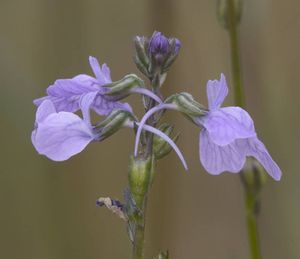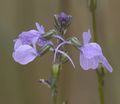Difference between revisions of "Nuttallanthus texanus"
| (10 intermediate revisions by 2 users not shown) | |||
| Line 1: | Line 1: | ||
| − | '''Common | + | * Scientific Name: ''Nuttallanthus texanus'' |
| + | * Family: Plantaginaceae | ||
| + | * Common Names: blue toadflax, Texas toadflax, wild toadflax, large-flowered toadflax. | ||
| + | * Synonyms/Misapplications: ''Linaria'' ''canadensis'' var. ''texanus, Linaria texana'' | ||
| + | * Codon: NUTCAN | ||
| + | ---- | ||
| + | [[File:NUTTEX1.jpg |thumb|Photo by Rod Gilbert, also featured on Main Page]] | ||
| + | ===Taxonomy=== | ||
| + | {{Taxobox | ||
| + | | image = | ||
| + | | image_caption = photo by Rod Gilbert, also featured on Main Page | ||
| + | | name = | ||
| + | | regnum = [[Plant]]ae | ||
| + | | subregnum = Viridiplantae | ||
| + | | phylum = Tracheophyta | ||
| + | | subphylum= Spermatophytina | ||
| + | | classis = Magnoliopsida | ||
| + | | subclassis = Asteranae | ||
| + | | ordo = Lamiales | ||
| + | | familia = Plantaginaceae | ||
| + | | genus = ''Nuttallanthus'' D.A. Sutton | ||
| + | | species = ''''' Nuttallanthus texanus''''' (Scheele) D.A. Sutton | ||
| + | | synonyms = *''Linaria texana'' Scheele | ||
| + | *''Linaria canadensis'' var. ''texana'' (Scheele) Pennell | ||
| + | }} | ||
| + | <ref>Integrated Taxonomic Information System. Retrieved from https://www.itis.gov/servlet/SingleRpt/SingleRpt?search_topic=TSN&search_value=503971#null</ref> | ||
| + | ===Description=== | ||
| + | Native or biennial herb, growing upright, 1-6 dm. tall. Produces decumbent side shoots which do no flower. | ||
| − | + | Cauline and basal leaves are narrow to obtuse, and glabrous. | |
| + | Inflorescence glandular-puberulent, flowers blue to violet, borne alternately in a raceme. | ||
| − | + | Sepals 5, basally connate. | |
| − | + | Each corolla is bilabiate with a smaller upper lip and a tri-lobed lower lip with a slender, curved nectar spur. There is a white ridge in the center of the lower corolla lobe. <ref>Bowcutt, F., & Hamman, Sarah. (2016). ''Vascular plants'' | |
| − | + | of the South Sound prairies'' (First ed.). Olympia, Washington: The Evergreen'' | |
| − | + | State College Press.</ref> | |
| − | + | ||
| − | + | ||
| − | + | ||
| − | + | ||
| − | + | ||
| − | = | + | Seeds prominently covered in tubercules, edges sharp.<ref name=":0">Hitchcock, C. L., Cronquist, A., Giblin, D., & Legler, |
| + | B. et al. (2018). ''Flora of the Pacific Northwest: an illustrated manual''. | ||
| + | Seattle: University of Washington Press.</ref> | ||
| − | = | + | In contrast, ''N. canadensis,'' with which it is often confused, has smaller flowers, 8-10 mm, with a 2-6 mm spur (''N. texana'' has a 10-12 mm long, and a 2-6 mm. spur), and nearly smooth seeds.<ref name=":1">Rare Plant Field Guide: WA - DNR. Retrieved from <nowiki>https://www.dnr.wa.gov/NHPfieldguide</nowiki></ref> |
| − | == | + | ===Bloom Period=== |
| + | May-June<ref>WTU Herbarium, Burke Museum, | ||
| + | & University of Washington. Retrieved from <nowiki>https://biology.burke.washington.edu/herbarium/imagecollection/taxon.php?Taxon=Nuttallanthus%20texanus</nowiki></ref> | ||
| − | == | + | ===Distribution=== |
| + | West Cascades, southwest BC to California, and southern and central US.<ref name=":0" /> | ||
| − | = | + | It is rare in Washington, known from a few number of extant populations.<ref name=":1" /> |
| − | == | + | ===Habitat=== |
| + | Glacial outwash prairies, or disturbed areas with a sandy or gravelly substrate, areas with very little organic matter in the soil. Low elevations in Washington. Associated species include red fescue (''Festuca rubra),'' hairy cat's ear ''(Hypochaeris'' radicata)'','' upland larkspur (''Delphinium nuttallii).''<ref name=":1" /> | ||
| − | == | + | ===Uses=== |
| + | A source of pollen for a variety of butterfly species.<ref>Butterfly Garden Plants: Texas Toadflax. (2019). Retrieved from <nowiki>http://nababutterfly.com/texas-toadflax/</nowiki></ref> | ||
| − | ==References== | + | ===Photo Gallery=== |
| + | <gallery> | ||
| + | File:NUTTEX1.jpg|Photo by Rod Gilbert | ||
| + | File:NUTTEX2.jpg|Photo by Rod Gilbert | ||
| + | </gallery> | ||
| + | |||
| + | ===References=== | ||
| + | <references /> | ||
Latest revision as of 22:14, 20 March 2021
- Scientific Name: Nuttallanthus texanus
- Family: Plantaginaceae
- Common Names: blue toadflax, Texas toadflax, wild toadflax, large-flowered toadflax.
- Synonyms/Misapplications: Linaria canadensis var. texanus, Linaria texana
- Codon: NUTCAN
Contents
Taxonomy
| Scientific classification | |
|---|---|
| Kingdom: | Plantae |
| Subkingdom: | Viridiplantae |
| Phylum: | Tracheophyta |
| Subphylum: | Spermatophytina |
| Class: | Magnoliopsida |
| Subclass: | Asteranae |
| Order: | Lamiales |
| Family: | Plantaginaceae |
| Genus: | Nuttallanthus D.A. Sutton |
| Species: | Nuttallanthus texanus (Scheele) D.A. Sutton |
| Synonyms | |
| |
Description
Native or biennial herb, growing upright, 1-6 dm. tall. Produces decumbent side shoots which do no flower.
Cauline and basal leaves are narrow to obtuse, and glabrous.
Inflorescence glandular-puberulent, flowers blue to violet, borne alternately in a raceme.
Sepals 5, basally connate.
Each corolla is bilabiate with a smaller upper lip and a tri-lobed lower lip with a slender, curved nectar spur. There is a white ridge in the center of the lower corolla lobe. [2]
Seeds prominently covered in tubercules, edges sharp.[3]
In contrast, N. canadensis, with which it is often confused, has smaller flowers, 8-10 mm, with a 2-6 mm spur (N. texana has a 10-12 mm long, and a 2-6 mm. spur), and nearly smooth seeds.[4]
Bloom Period
May-June[5]
Distribution
West Cascades, southwest BC to California, and southern and central US.[3]
It is rare in Washington, known from a few number of extant populations.[4]
Habitat
Glacial outwash prairies, or disturbed areas with a sandy or gravelly substrate, areas with very little organic matter in the soil. Low elevations in Washington. Associated species include red fescue (Festuca rubra), hairy cat's ear (Hypochaeris radicata), upland larkspur (Delphinium nuttallii).[4]
Uses
A source of pollen for a variety of butterfly species.[6]
Photo Gallery
References
- ↑ Integrated Taxonomic Information System. Retrieved from https://www.itis.gov/servlet/SingleRpt/SingleRpt?search_topic=TSN&search_value=503971#null
- ↑ Bowcutt, F., & Hamman, Sarah. (2016). Vascular plants of the South Sound prairies (First ed.). Olympia, Washington: The Evergreen State College Press.
- ↑ 3.0 3.1 Hitchcock, C. L., Cronquist, A., Giblin, D., & Legler, B. et al. (2018). Flora of the Pacific Northwest: an illustrated manual. Seattle: University of Washington Press.
- ↑ 4.0 4.1 4.2 Rare Plant Field Guide: WA - DNR. Retrieved from https://www.dnr.wa.gov/NHPfieldguide
- ↑ WTU Herbarium, Burke Museum, & University of Washington. Retrieved from https://biology.burke.washington.edu/herbarium/imagecollection/taxon.php?Taxon=Nuttallanthus%20texanus
- ↑ Butterfly Garden Plants: Texas Toadflax. (2019). Retrieved from http://nababutterfly.com/texas-toadflax/



